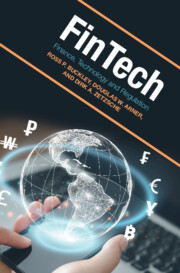Book contents
- FinTech
- FinTech
- Copyright page
- Contents
- Figures
- Acknowledgements
- Abbreviations and Technical Terms
- 1 Introduction
- Part I Digital Transformation of Finance and Regulation
- Part II Addressing the Challenges of Innovation in Finance
- Part III Building Better Financial Systems
- 12 Building the Infrastructure for Digital Financial Transformation
- 13 Digital Identity
- 14 Electronic Payments, Stablecoins, and Central Bank Digital Currencies
- 15 Digital Financial Transformation
- Part IV From FinTech to TechFin to BigTech to FinTech 4.0
- Part V Conclusion
- Index
12 - Building the Infrastructure for Digital Financial Transformation
from Part III - Building Better Financial Systems
Published online by Cambridge University Press: 09 November 2023
- FinTech
- FinTech
- Copyright page
- Contents
- Figures
- Acknowledgements
- Abbreviations and Technical Terms
- 1 Introduction
- Part I Digital Transformation of Finance and Regulation
- Part II Addressing the Challenges of Innovation in Finance
- Part III Building Better Financial Systems
- 12 Building the Infrastructure for Digital Financial Transformation
- 13 Digital Identity
- 14 Electronic Payments, Stablecoins, and Central Bank Digital Currencies
- 15 Digital Financial Transformation
- Part IV From FinTech to TechFin to BigTech to FinTech 4.0
- Part V Conclusion
- Index
Summary
The full potential of FinTech may best be realised by a progressive approach to the development of the underlying infrastructure for digital financial transformation. We suggest in this chapter the best way to think about such a strategy is to focus on four primary pillars. The first pillar requires the building of digital identity, simplified account opening, and e-KYC systems. The second pillar is open interoperable electronic payment systems. The third pillar involves using the infrastructure of the first and second pillars to underpin electronic provision of government services and payments. The fourth pillar is the design and development of digital financial markets and systems, which supports broader access to finance and investment. Implementing the four pillars is a major journey for any economy, but one with tremendous potential to transform financial systems, economies, and societies.
- Type
- Chapter
- Information
- FinTechFinance, Technology and Regulation, pp. 181 - 193Publisher: Cambridge University PressPrint publication year: 2023



